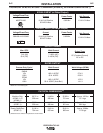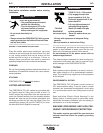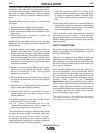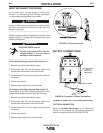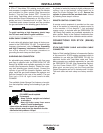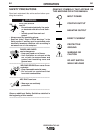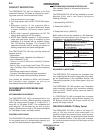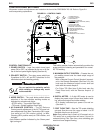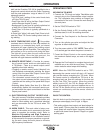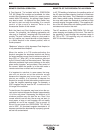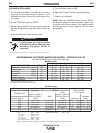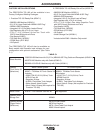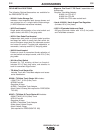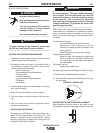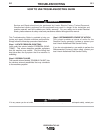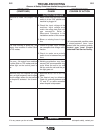
B-4
OPERATION
B-4
8. PULSE TIG CONTROL – The Pulse TIG feature
built into the Precision TIG 185 is simplified to be a
single knob control which sets the Pulse Frequency
over the peak pulses/sec. range of about 0.1 to 20
pulses per second:
• Full CCW (min.) setting of the control knob shuts
off Pulse TIG (0.0 pps).
• Peak Pulse level is set by the Max. Output Control
and the Remote Amptrol (if used).
• Background Current level is typically optimized at
a fixed 50% of Peak Pulse level setting.
• Peak Pulse % On-time is typically optimized at a
fixed50%.
A Green light "blinks" with each Peak Pulse to indi-
cate the Pulse TIG Control setting before and dur-
ing welding.
9. OVER TEMPERATURE LIGHT - If the welder
overheats due to blocked air flow, high ambient air
temperature, or exceeded duty cycle, an internal
thermostat will open disabling the welding output
and this yellow light will illuminate. The cooling fans
will continue to run to cool the unit during this time.
The light will go out when the unit cools and the
thermostat resets. Once the light goes out, the
machine will again become available to weld.
10. REMOTE RECEPTACLE – Provides for connec-
tion of remote control and/or arc start switch only
in TIG Mode: ( There is no remote output control
capability when stick welding.
• Plugging a remote current control (Amptrol) into
this receptacle automatically switches the output
control from the panel Max Output Control (See
Item 5) to the remote control.
• The connected remote control will then control
the output current between the Min. range of the
machine and the setting of the panel Max Output
Control.
• Switching Mode Switch (See Item 3) to Stick will
automatically disable the connected remote con-
trol and switch the output control back to the Max
Output panel control.
11. ELECTRODE/GAS OUTPUT RECEPTACLE -
This quick connect Twist-Mate receptacle provides
electrical connection to the electrode holder and
cable for Stick welding and a combined electrical
and gas connection for the TIG torch when TIG
welding.
12. WORK CABLE - This work cable is factory con-
nected to the welder and is connected to the work
piece to complete the welding circuit. Refer to
Machine Grounding and High Frequency
Interference Protection in the Installation section
of this manual for the proper procedure on ground-
ing the work clamp and work piece to minimize
high frequency interference.
OPERATING STEPS
WELDING IN TIG MODE
1. Connect the TIG torch and cable Twist-Mate quick
connect plug to the Electrode/Gas output recepta-
cle. This receptacle also contains an integral gas
connection for the torch. Connect the work clamp to
the work piece.
2. Set the TIG/STICK switch to “TIG”.
3. Set the Polarity Switch to DC- for welding steel or
stainless steel; or to AC for welding aluminum.
4. Connect the Foot Amptrol to the Remote Control
Connector.
5. Turn on the cylinder gas valve and adjust the flow
regulator to obtain desired flow.
6. Turn the power switch to “ON”. NOTE: There will be
a 15 second gas flow when the power is turned on.
7. Preset the Output Control on the control panel to
the maximum desired amps, as read on the digital
meter.
8. Depress the Foot Amptrol to energize the torch and
establish an an arc with the work piece. The digital
meter reads the actual amps while welding.
NOTE: When the TIG/STICK switch is set to “TIG”,
depressing the remote control will start a 0.5 second
gas pre-flow before energizing the TIG torch. When
the remote control is released the TIG torch is de-
energized and gas flow will continue for the time set
by the Post Flow Time control. When the polarity
switch is set to DC, the TIG Arc Starter will turn on
and off automatically to start and stabilize the arc. In
AC the TIG Arc Starter will turn on with the output and
remain on continuously until the remote control is
released.
PULSE TIG CONTROL
Use this knob to set the frequency or the number of
pulses per second(pps), from 0.1pps to 20pps.
• This setting adjusts heat output and bead shape for
travel speed. Thinner plate that is welded with faster
travel speed will require higher frequency than thick-
er plate with slower travel speed. 2-3pps is a typical
starting point.
PRECISION TIG 185



